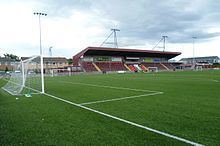Population 10,190 (2009 est.) Post town LARBERT Dialling code 01324 | OS grid reference NS875831 Sovereign state United Kingdom Postcode district FK5 Local time Monday 11:58 AM | |
 | ||
Weather 12°C, Wind E at 13 km/h, 64% Humidity Lieutenancy areas Falkirk, Stirling and Falkirk | ||
5 star stenhousemuir thump diamonds
Stenhousemuir /ˈstɛnaʊsmjʊər/ (Scottish Gaelic: Am Featha Taigh nan Clach) is a town in the Central Lowlands of Scotland. It lies in the Forth Valley within the Falkirk council area of Scotland. The town is 2.0 miles (3.2 km) north-northwest of Falkirk and directly adjoins to Larbert in the west, where the nearest rail access is located. The villages of Carron and Carronshore adjoin Stenhousemuir to the east but to a lesser extent. At the 2001 census it showed that it had a resident population of 10,351 but according to a 2009 estimate this has been revised to around 10,190 residents.
Contents
- 5 star stenhousemuir thump diamonds
- Map of Stenhousemuir UK
- History
- Sports
- Landmarks
- Notable People
- References
Map of Stenhousemuir, UK
In 2008, a £15 million town centre development scheme was completed and opened which provides a new civic square, a library and large retailing outlets for Stenhousemuir.
History
The "stone house" from which the village took its name was a Roman building on the north of the Carron River Valley known in later centuries as Arthur's O'on, i.e. King Arthur's oven. It is no longer to be seen, having been demolished to rebuild a dam on the River Carron by Sir Michael Bruce of Stenhouse in 1743. The stones were swept away in a flood soon after. However, detailed drawings had been made in the 1720s and a replica was made in 1763 to serve as a dovecote on the roof of the stable block of Penicuik House in Midlothian, and this remains. The site of the original building has been localised to the garden of a modern house on a housing estate, apparently by the American academic Norma Lorre Goodrich (1917–2006). Stenhousemuir became home to the "Falkirk Tryst" from 1785 - one of the largest gatherings of livestock farmers and buyers from all over Scotland and beyond. After the decline of the Tryst in Crieff, the Falkirk Tryst came to be held more frequently, on the second Tuesdays of August, September and October each year. Thomas Gisbourne in his "Essay on Agriculture" described the Tryst in 1849 as "a scene to which Great Britain, perhaps even the whole world, does not afford a parallel". The Trysts continued until the late 19th century.
The town was home to the McCowan’s toffee factory, established in 1922, who made both traditional toffee and also the Wham Bar.
Sports
Stenhousemuir currently has two football teams (Stenhousemuir and East Stirlingshire) who ground-share at Stenhousemuir's Ochilview Park ground, a cricket club and a golf club. The Tryst Golf Club, built in 1885, has its clubhouse in Burnhead Road, which is arguably in Larbert.
The Cricket Club has been in existence since 1876 and has a very long and proud history with many successes in national club cricket. It has also produced a number of international player representing Scotland and had a number of notable cricket professionals playing for the club many of whom are noted internationalists for their respective countries also e.g. Abdul Qadir.
Landmarks
Ochilview Park, McCowan's Toffee Factory (now demolished), Falkirk Tryst Golf Club and Stenhousemuir Cricket Club are all accessible via Tryst Road, a prominent stretch of road leading North out of the village. The street is so called because it was the site of the annual Tryst. On the anniversary of the Tryst in September each year, a travelling funfair comes to the site.
There are two churches in the village: nearer the centre of the village is Larbert East Church with its imposing tower, meanwhile one third of a mile to the east of the village centre on the aptly named Church Street is the Stenhouse and Carron church which is smaller but more distinctive architecturally, designed in 1897 by the firm of John James Burnet. The village is home to a Salvation Army church and community centre housed in a modern building adjacent to Stenhousemuir Primary school.
The shopping area of Stenhousemuir was renovated in 2008. A new library with community area, football pitch and new shops including a 40,000 sq Asda supermarket alongside relocation of a number of existing businesses. The shopping area now encompasses a local butcher, pharmacy, banks, food outlets, florists and small chain stores.
Part of the regeneration resulted in construction of a new community centre and rebuild of the medical centre which provides additional NHS support services to the area. Further regeneration will see the replacement of the old police station with community housing with a new facade designed to reflect the original building.
